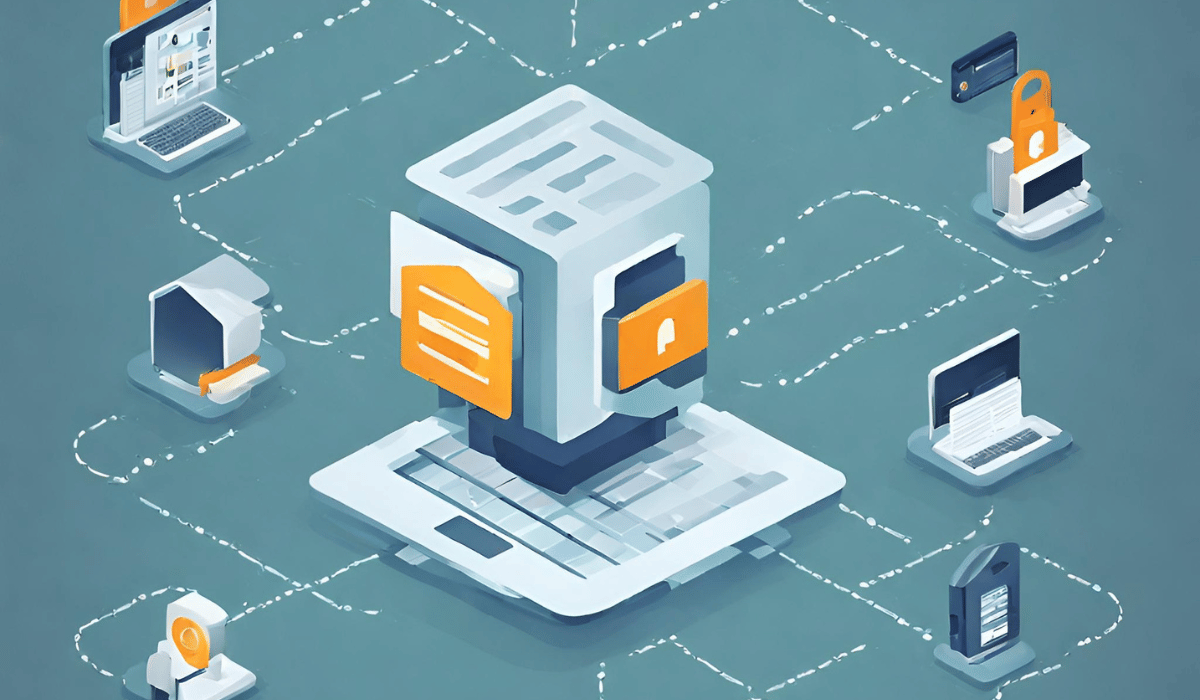Introduction
The Open Systems Interconnection (OSI) model is a theoretical framework that describes the communication functions of a telecommunication or computing system. It consists of seven layers, each with a specific function in the communication process. In this article, we will focus on the subsequent layer of the OSI model, the Data Link Layer, and its role in data encryption.
Importance Of Data Encryption

Data encryption converts plaintext into ciphertext, unreadable without the proper decryption key. It is an important security measure that helps protect sensitive information from unauthorized access. Encryption can be applied at various levels of the OSI model, including the Data Link Layer. In particular, encrypting data at the Data Link Layer can help prevent unauthorized access to data during transmission over a network. This is especially significant when the network is insecure, such as in public Wi-Fi hotspots or unsecured networks. Encrypting data at the Data Link Layer protects the information from interception and unauthorized access, ensuring that sensitive information remains confidential. Encryption can also be used to defend data at rest, such as on a hard drive or in a database, by encrypting the data before it is stored. This includes an additional layer of security to prevent unauthorized access to sensitive information.
Understanding Data Encryption at the Data Link Layer of the OSI Model
Encrypt Data At The Data-Link Layer Of The OSI Model

One of the most commonly used encryption protocols at the Data Link Layer of the OSI model is the Point-to-Point Protocol (PPP) with the Encryption Control Protocol (ECP). This protocol combination provides encryption and compression of data packets, ensuring that sensitive information remains confidential and secure during transmission over the network. Other protocols, such as Secure Sockets Layer (SSL) and Transport Layer Security (TLS), are commonly used to encrypt data at higher OSI model layers.
Encrypt Data At The Data-Link Layer Of The TCP/IP Stack
Point-to-Point Protocol (PPP) with the Encryption Control Protocol (ECP) is sometimes used to encrypt data at the data-link layer of the TCP/IP stack.
Data Link Layer
The Data Link Layer is the subsequent layer of the OSI model and the TCP/IP stack. This layer provides reliable and error-free data transfer between two nodes on the same physical network. It does this by breaking up the data into frames, adding a header and a trailer to each frame, and transmitting them over the physical medium. The Data Link Layer handles flow control, error detection and correction, and media access control. Examples of protocols that operate at this layer include Ethernet, Token Ring, and Point-to-Point Protocol (PPP).
Data Encryption At The Data Link Layer
Data encryption at the Data Link Layer involves encrypting the data before it is transmitted over the physical medium. This process offers an extra layer of security to prevent unauthorized access to the data. Encryption at this layer can be done using symmetric key encryption, so the same key is used for encryption and decryption, or asymmetric key encryption, where different keys are used for encryption and decryption. Protocols that provide encryption at this layer include Point-to-Point Tunneling Protocol (PPTP) and Layer 2 Tunneling Protocol (L2TP).
MAC Layer Encryption
The MAC (Media Access Control) layer controls access to the physical medium, such as a network cable or wireless channel. Encryption at this layer can help prevent unauthorized access to the network by encrypting the data transmitted over the physical medium. This layer can use symmetric key encryption, where the same key is used for encryption and decryption, or asymmetric key encryption, where different keys are used for encryption and decryption. Examples of protocols that provide encryption at this layer include Wired Equivalent Privacy (WEP) and Wi-Fi Protected Access (WPA).
LLC Layer Encryption
The LLC (Logical Link Control) layer provides a reliable data link between two devices on a network. Encryption at this layer can help ensure the confidentiality and integrity of the transmitted data. One example of a protocol that provides encryption at the LLC layer is the Link Encryption Protocol (LEP), used in some military and government networks. LEP uses symmetric key encryption to encrypt data at the LLC layer and can provide end-to-end encryption between two devices on a network.
Another example of a protocol that provides encryption at the LLC layer is the Safe Sockets Layer (SSL) protocol, which is used to protect web traffic. SSL uses asymmetric key encryption to encrypt data at the LLC layer and can provide secure communication between a web server and a client browser.
Virtual Private Networks (VPNs)

Virtual Private Networks (VPNs) are a way to securely connect two or more devices over a public network, such as the internet. VPNs create a safe and encrypted tunnel between devices, allowing them to communicate as if on a private network.VPNs use various protocols, such as Point-to-Point Tunneling Protocol (PPTP), Layer 2 Tunneling Protocol (L2TP), and Internet Protocol Security (IPsec), to establish a secure connection between devices. These protocols use encryption to protect data transmitted between devices and ensure that only authorized users can access the network.
Businesses commonly use VPNs to allow employees to access company resources from remote locations securely. Individuals also use them to protect online privacy and bypass censorship in certain countries.
Wireless Encryption Protocols
Wireless encryption protocols secure wireless networks and protect data transmitted over them. The most common wireless encryption protocol is Wi-Fi Protected Access (WPA), which has several versions, including WPA2 and WPA3. These protocols use encryption to protect data transmitted between devices and ensure that only authorized users can access the network.WPA2 is currently the most widely used wireless encryption protocol and is considered very secure when properly implemented. WPA3, the latest protocol version, offers even stronger security features, including protection against brute-force attacks and improved encryption algorithms.
It is significant to use strong passwords and keep them secure when using wireless encryption protocols to protect your network and data. Additionally, it is recommended to periodically update your wireless encryption protocol to ensure the highest level of security possible.
Implementing Data Link Layer Encryption
Data link layer encryption is another important step in securing your network and data. Data link layer encryption involves encrypting the data as it is transmitted between devices on the network. This provides an extra layer of security beyond wireless encryption protocols. One common data link layer encryption protocol is the Point-to-Point Protocol (PPP), commonly used in Virtual Private Network (VPN) connections. PPP can be configured to use various encryption algorithms, like Advanced Encryption Standard (AES) or Triple Data Encryption Standard (3DES), to protect the transmitted data.
Another data link layer encryption protocol is the Link Layer Security (LLS) protocol used in Ethernet networks. LLS provides authentication and encryption for Ethernet frames, ensuring that only authorized devices can access the network and that data is protected from unauthorized access.
Implementing data link layer encryption can be complex and requires careful configuration and management. However, its added security is well worth the effort, particularly for businesses and organizations that handle sensitive or confidential data.
Common Tools For Data Link Layer Encryption
There are several common tools for data link layer encryption, including:
1. Virtual Private Networks (VPNs): VPNs create a secure, encrypted tunnel between two devices or networks over a public network like the internet. This provides a high level of security for data in transit.
2. Secure Sockets Layer (SSL) and Transport Layer Security (TLS): SSL and TLS are protocols that encrypt data transmitted over the internet. They are commonly used for secure web browsing and email.
3. IEEE 802.1X: This standard provides port-based network access control, which requires users or devices to authenticate before being granted network access. It can be used in conjunction with other encryption methods to provide an additional layer of security.
4. Media Access Control Security (MACsec): MACsec provides encryption and authentication for Ethernet frames at the data link layer. It can secure communications between switches, routers, and other network devices.
5. Data Encryption Standard (DES) and Advanced Encryption Standard (AES): These encryption algorithms can be used at the data link layer to provide confidentiality and integrity for data in transit.
Limitations Of Data Link Layer Encryption
The Data Link Layer Encryption has certain limitations that should be considered. Here are some of them:
1. Limited protection: Data Link Layer Encryption only protects the data transmitted over the network. It does not protect the data that is stored on the devices.
2. Key management: Key management can be challenging, especially in large networks. If the keys are not managed properly, it can lead to security breaches.
3. Performance impact: Data Link Layer Encryption can impact the network, especially if the devices are not powerful enough to handle the encryption and decryption.
4. Compatibility issues: Data Link Layer Encryption may not be compatible with all devices and software. This can cause issues when trying to implement it on a network.
5. Cost: Implementing Data Link Layer Encryption can be expensive, especially if the network is large and requires many devices to be encrypted.
Best Practices For Executing Data Link Layer Encryption
Here are some best practices for implementing data link layer encryption:
1. Choose a strong encryption algorithm: Use a strong encryption algorithm like AES, which provides robust security against attacks.
2. Use a strong authentication system: Implement a strong authentication system to ensure only authorized users can access the network.
3. Regularly update encryption keys: Regularly update encryption keys to prevent hackers from decrypting intercepted data.
4. Monitor network activity: Monitor network activity to detect any suspicious behavior that may indicate an attack.
5. Implement access controls: Implement access controls to restrict access to sensitive data and network resources.
6. Use a virtual private network (VPN): Use a VPN to encrypt all network traffic between remote users and the network, even when they are using public Wi-Fi.
7. Implement physical security measures: Implement physical security measures to prevent unauthorized access to network devices and infrastructure.
Emerging Trends In Data Link Layer Encryption
One emerging data link layer encryption trend uses quantum key distribution (QKD) technology. QKD uses the principles of quantum mechanics to produce and distribute encryption keys, which are then used to encrypt data at the data link layer. QKD is considered highly secure, as any attempt to intercept or eavesdrop on the transmission of the encryption keys would be immediately detected.
Another emerging trend is using software-defined networking (SDN) to improve data link layer security. SDN allows for more granular control over network traffic, which can be used to detect and mitigate potential security threats at the data link layer.
Frequently Asked Questions (FAQs)
What Is Data Encryption At The Data Link Layer?
Data encryption at the data link layer secures data as it is transmitted between two devices over a network. This is typically done using protocols such as the Point-to-Point Protocol (PPP) or the Layer 2 Tunneling Protocol (L2TP). Data encryption at the data link layer involves encrypting the entire data packet, including the header and trailer, to ensure that the data cannot be intercepted or tampered with during transmission.
What Is A VPN, And How Does It Use Data Link Layer Encryption?
A VPN, or Virtual Private Network, is a technology that allows users to connect to a private network over the internet securely. VPNs use data link layer encryption to protect the data transmitted between the client’s device and the VPN server. This encryption is typically implemented using protocols such as Point-to-Point Tunneling Protocol (PPTP), Layer 2 Tunneling Protocol (L2TP), or Internet Protocol Security (IPsec). When a handler connects to a VPN, their device establishes a secure connection with the VPN server using data link layer encryption. This encryption ensures that any data transmitted between the user’s device and the VPN server is protected from interception or tampering by unauthorized third parties. Once the secure connection is recognized, the user can access resources on the private network as if physically connected.
How Can I Overcome The Limitations Of Data Link Layer Encryption?
There are several ways to overcome the limitations of data link layer encryption. One approach is implementing multi-layer encryption, which involves using different encryption methods at different network stack layers. This can provide additional layers of protection against cyber threats, making it more difficult for attackers to intercept or decrypt data. Another approach is to use advanced encryption algorithms and protocols specifically designed for data link layer security. For example, the IEEE 802.1AE standard, or MACsec, provides strong encryption and authentication for Ethernet networks at the data link layer.
Conclusion
The data link layer is crucial to network security by providing a secure communication channel between devices. Implementing encryption and authentication protocols, such as MACsec, is important to protect against unauthorized access and data breaches. Regular updates and patches should also be applied to maintain the effectiveness of these security measures. By following these practices, organizations can help ensure the integrity and confidentiality of their data.
It is important to prioritize data security in any network. Implementing MACsec and other data link layer encryption protocols can protect sensitive information from unauthorized access and interception. In addition to encryption, it is also important to regularly update and patch network systems, implement strong authentication measures, and train employees on proper security practices. Organizations can better safeguard their data and prevent potential breaches by taking a comprehensive approach to network security.
